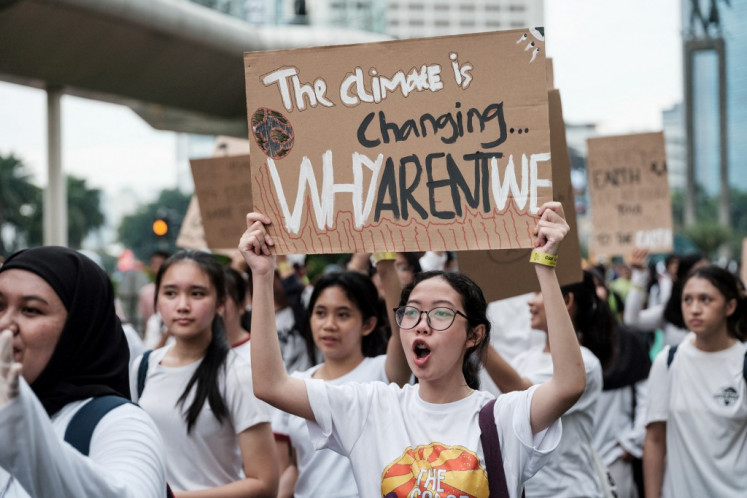'Come Hell or High Water' sheds light on environmental struggles
Up close: Derrick Evans is seen outside his great grandfatherâs house in Turkey Creek after Hurricane Katrina, leaning on a sign he built before the storm
Change Size

U
span class="inline inline-center">Up close: Derrick Evans is seen outside his great grandfather's house in Turkey Creek after Hurricane Katrina, leaning on a sign he built before the storm. Leahmahan.com/Spencer Weiner/SAWfoto.com
What does Turkey Creek, Mississippi ' 320 acres of green-brown wetlands, settled in 1866 by a group of emancipated African Americans ' have to do with Indonesia? Plenty.
The lessons learned by a small town battling corporate interests are globally relevant, as shown in the award-winning documentary film Come Hell or High Water: The Battle for Turkey Creek.
'Come Hell or High Water took me 12 years to make. It is about a community on the Gulf Coast in the US ' a place that's very affected by natural and man-made disasters,' said director Leah Mahan, referring to Turkey Creek in Mississippi, when introducing her film shortly before its screening.
Derrick Evans is the star. And while 'star' isn't proper documentary parlance 'Evans is the 'subject', technically ' and he's easy to root for.
This isn't because he and director Mahan are friends (the two met years ago on an internship); it's because Evans is a sixth-generation resident of Turkey Creek's 320-acre wetlands. The stakes are manifest in him.
'When your great grandfather's grandfather, who was a slave, lived here, you can't know how continuing and empowering that feels.'
When Evans' ancestors' graves are bulldozed to make way for the sprawling city of Gulfport, he leaves work as a schoolteacher in Boston to attend to the troubles back home.
Before driving south, Evans tells his students: 'Racism is the most profitable invention of the last 200 years.'
The trend continued in Turkey Creek, where locals, mostly black, feel bullied by neighboring city officials and developers, mostly white, who are dubious of alleged wrongs.
One developer says, 'I'm for economic development. That means income, jobs. Now be careful what you wish for.' A councilman says, for the right amount of money, people can get new memories. The Gulfport mayor concludes that development foes are 'dumb bastards'.

Yet Turkey Creek residents were reluctant to hand over their land after years of abuse. Developmental hazards disproportionately impact communities of color, Evans says in the film, and over the years Turkey Creek had become a 'dumping ground' for the infrastructure unwanted elsewhere: an airport, a sewage facility and, if developers can help it, a highway.
There are analogies to Indonesia's ongoing developments, in which environmental groups have raised concerns that untrammeled growth will damage existing resources and communities.
Mahan admitted she was curious how her film 'would resonate here'.
'I never imagined I would be showing it in Indonesia,' she said following the screening, held at the American Ambassador's residence in Jakarta.
The screening marked the beginning of Mahan and film expert Irene Taylor Brodsky's tour of Indonesia. They will continue from Java to Sulawesi and Sumatra, sharing their experiences and conducting workshops.
The screenings aim to foster cross-cultural understanding as part of the American Film Showcase (AFS), which brings American films and filmmakers to US embassies and audiences across the world.
US Ambassador Robert O. Blake Jr. explained the importance of AFS at the event's opening. 'The creative industry in Indonesia is just taking off, and it's wonderful to have two award-winning directors come and give further impetus to that growth,' he says.
He said Indonesian-American relations have 'never been closer', and hoped the films would testify to the countries' similarities. 'Indonesians will relate to Leah and Irene's works. They tell stories about common people struggling to overcome.'
The film has indeed exceeded its original promise; at first Mahan had wanted only to document a story that wasn't being told in mainstream media. But when Hurricane Katrina hit the Gulf Coast in 2005, Evans' and Mahan's work was prolonged.
'Things just happened in stages,' she said. 'But the sense I had to finish guided it.'
Mahan and Evans returned to Mississippi. In the wake of the destruction, the state received federal aid money, which instead of being used to help communities like Turkey Creek, the governor put toward his own development efforts. Driving through Gulfport, they saw apartments sprouting up. Trees were clear-cut in Turkey Creek. 'It looks like someone died,' Evans said.

Turkey Creek's fortunes changes when Evans began drawing attention to its rare wildlife. Environmental groups like the Sierra Club and the Environmental Protection Agency have intervened to help challenge developers.
Evans again saw his duties extended to include environmental advocacy on an even larger scale in 2010 to match the damage of the BP Gulf Coast oil spill. And Mahan continues to show her film around the world.
'So what's the end of the story?' she was asked.
'Some houses got historic funding,' Mahan said. 'A lot of elders are gone. There was no bottom to this project. Derrick is still involved trying to help Turkey Creek exist. He's gotten very involved regionally.'
She added that there are lots of similar stories, which invited another question: how is hers different?
'The kind of work Derrick is doing is really changing the environmental movement. He is changing the way we look at leadership, broadening the movement.'
Mahan was optimistic about the power of film to affect change.
'Film is an excuse to have a dialogue. It's been a tool for people in the EPA [US Environmental Protection Agency] who want to see things done a different way. Screening allows us to ask: how can we do things differently? It's one tool in the chest.'
_____________________
The writer is an intern at The Jakarta Post.









